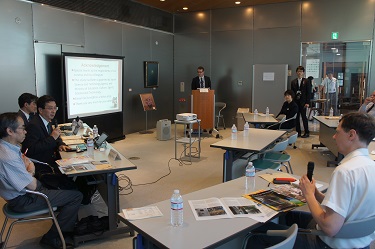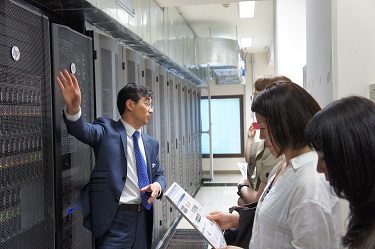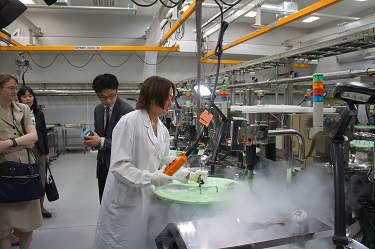Sixth “UTokyo Research, On Site” Tour - In Search of Personalized Medicine: Genome Science at the University of Tokyo

Date of activity: July 10, 2015
Genomics is a rapidly developing scientific field that deals with understanding the genetic basis for how our bodies work and presents promising possibilities for helping us to treat a wide range of diseases. The "Sixth UTokyo Research, on site" event, held jointly by the University of Tokyo's Institute of Medical Science (IMSUT) and the Medical Genomics Research Initiative on Friday, July 10, 2015, showcased the latest advancements in this exciting area to members of the media and various embassies. A total of 14 participants (2 media professionals, 11 embassy attachés and one ambassador) gathered at IMSUT on the Shirokanedai Campus to learn about and experience up-close the world of genomics and the potential it holds for personalized medicine and disease prevention.
The event started with a briefing session that introduced participants to genomics. After opening remarks from Public Relations Office Director Professor Shinji Suzuki, three professors gave presentations relating to genome science from their areas of expertise. First, Professor and Dean of IMSUT Yoshinori Murakami gave a general overview of the Institute and the field of genome science. He talked about the history of the Institute, which dates back to 1892, mentioning that in 2017 the Institute is coming up on the 125th anniversary of its founding and the 50th anniversary of its incorporation as an institute. Professor Murakami also described some of the recent efforts in which the Institute is actively engaging, such as the Human Genome Center’s study of ethical, legal and social issues (ELSI) in human genome science, the BioBank Japan project and the Medical Genomics Research Initiative.
Next, Professor Seiya Imoto talked about how supercomputers are integral to analyzing human genome sequence data, and introduced IMSUT’s supercomputer, Shirokane3. He explained that combining the processing power of supercomputers like the Shirokane3 with mathematical models to make sense of genome sequence data will greatly advance research into cancer treatments and help predict the prognosis of patients.
The last speaker was Professor Kaori Muto, who discussed ELSI in genomic research. She introduced IMSUT’s Department of Public Policy, which was established in 2007 and was the first academic department made to address ethical issues in the biomedical sciences in Japan. Professor Muto highlighted some of the Department’s efforts to observe the public’s awareness of and attitudes towards genomics research (including BioBank Japan) and commercial genetic testing services. She also discussed how the Department offers ethics consultations for researchers and provides strategies to the government, scientists and medical practitioners regarding the use of genomic research data.
Following a question-and-answer session and a coffee break during which attendees engaged in free discussion with the professors, tours were given of the Shirokane3 supercomputer and the fully automated DNA and tissue banking and partially automated serum banking systems of BioBank Japan.
The Shirokane3 supercomputer, which commenced operations in April 2015, is the fastest supercomputer in the field of life sciences research in Japan. Its 422-teraflop, 34.2-petabyte computer system is used to store and analyze human genome sequence data. The supercomputer’s capacity can be extended to the point that it can hold the data of one million people (the size of the whole genome sequence data for one person is slightly over 100 gigabytes). The Shirokane3 also utilizes an indirect evaporation-type cooling system—the first of its kind at a Japanese university or institute—that reduces energy consumption. This supercomputer is used not only by IMSUT researchers, but also those from other universities and institutions. Tour participants were able to walk around the supercomputer and see it in action up close.
The facilities of BioBank Japan, located on the Shirokanedai Campus, collect and store the DNA, serum and clinical information of 220,000 individuals suffering from 51 different diseases. One of the largest patient-oriented biobanks in the world, BioBank Japan collects samples from consenting patients, including those who are participating in clinical trials and those who have rare or untreatable diseases. Tour participants visited BioBank Japan’s automated DNA bank which holds one million tubes at 4°C, the serum and plasma bank of 58 liquid nitrogen tanks that holds 3.34 million tubes at -150°C, and the tissue bank of 12 automated liquid nitrogen tanks that holds 48,000 tubes at -150°C.
The attendees showed great interest in both the briefing session and the tours, listening intently and asking the professors many questions about the facilities and the possibilities for future international partnerships and research development.

Professor Murakami answering a question from a member of the media 
Professor Imoto explaining the Shirokane3 supercomputer to tour participants 
BioBank Japan's serum and plasma bank







